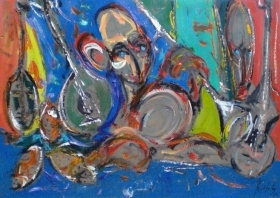Particolare attenzione rivolgiamo alla postura dei nostri pazienti. Per postura possiamo intendere la posizione del corpo nello spazio e la relazione spaziale tra i segmenti scheletrici, il cui fine è il mantenimento dell’equilibrio (funzione antigravitaria), sia in condizioni statiche che dinamiche, cui concorrono fattori neurofisiologici, biomeccanici, psicoemotivi e relazionali, legati anche all’evoluzione della specie.
La disciplina che si occupa dello studio scientifico e clinico della postura è la posturologia. La POSTUROLOGIA, poichè branca trasversale della medicina funzionle, coinvolge specialisti d'estrazione diversa, ma con modalità operative ed interpretative molto eterogenee. Molti sono i fattori che concorrono alla determinazione di una postura: neurofisiologici, biomeccanici, psicoemotivi e relazionali, legati anche all'evoluzione della specie. La postura, nella sua essenza neurofisiologica, non è altro che una modulazione del tono. Sappiamo che il tono muscolare è la risultante di una complessa serie di processi psiconeurofisiologici all'interno di un sistema cibernetico, il sistema tonico posturale.
Tale sistema ha delle entrate specifiche, costituite dalle informazioni provenienti dai recettori specifici della postura: il piede, l'occhio, l'apparato stomatognatico, la cute, l'apparato muscolo-scheletrico, l’orecchio interno, interconnessi tra loro. Pertanto una modificazione di uno di componenti componenti o sottosistemi, comporta una modificazione di tutto il sistema. Ad esempio, una modificazione dell’ingresso propriocettivo podalico è in grado di modificare le forie oculari e l’equilibrio occlusale, l’attività delle catene muscolari antigravitarie, le coordinate del centro di gravità, nonché la precisione e l’economia del sistema.
Studiare ed analizzare il complesso sistema posturale ed i suoi sottosistemi è dunque di fondamentale importanza per risalire alla causa che determina lo stato di sofferenza del paziente, somministrando la strategia terapeutica piu^ idonea per la risoluzione definitiva di determinate disfunzioni.
La riprogrammazione sistema neuro-muscolo-scheletrico, attraverso l'integrazione dell'osteopatia, della posturologia, della rieducazione posturale e del MEDical EXercise, che proponiamo ai nostri pazienti, parte proprio dai sopradescritti presupposti per arrivare alla determinazione del vero cambiamento necessario per il ristbilirsi di un buono stato di salute.
OSTEOPATHY AND POSTUROLOGY
We pay particular attention to the posture of our patients. By posture we can mean the position of the body in space and the spatial relationship between the skeletal segments, the purpose of which is to maintain balance (anti-gravity function), both in static and dynamic conditions, to which neurophysiological, biomechanical, psychoemotional and relational factors contribute also linked to the evolution of the species.
The discipline that deals with the scientific and clinical study of posture is posturology. POSTUROLOGY, as a transversal branch of functional medicine, involves specialists of different backgrounds, but with very heterogeneous operating and interpretative methods. There are many factors that contribute to the determination of a posture: neurophysiological, biomechanical, psycho-emotional and relational, also linked to the evolution of the species. Posture, in its neurophysiological essence, is nothing more than a tone modulation. We know that muscle tone is the result of a complex series of psychoneurophysiological processes within a cybernetic system, the postural tonic system. This system has specific inputs, consisting of information from specific receptors of posture: the foot, the eye, the stomatognathic system, the skin, the musculoskeletal system, the inner ear, all interconnected. Therefore a modification of one of the components or subsystems involves a modification of the whole system. For example, a modification of the breech proprioceptive input is able to modify the ocular phoria and the occlusal balance, the activity of the antigravity muscle chains, the coordinates of the center of gravity, as well as the precision and economy of the system.
Studying and analyzing the complex postural system and its subsystems is therefore of fundamental importance in order to trace the cause that determines the patient's state of suffering, administering the most suitable therapeutic strategy for the definitive resolution of certain dysfunctions.
The reprogramming of the neuro-musculoskeletal system, through the integration of osteopathy, posturology, postural re-education and the MEDical EXercise, which we offer to our patients, starts from the above-described assumptions to arrive at the determination of the real change necessary for recovery of a good state of health.
© Copyright 2024 OSTEOPATIA PERUGIA. All rights reserved.

